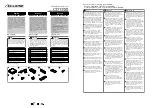
fm
G
enie
fm
G
enie
3
2
fm
G
enie
fm
G
enie
Welcome to your new
fmGenie radio aid system
A range of information guides are
supplied with your system.
For those new to radio aids, we
particularly recommend pages 12-17 of
this User Guide and new fmGenie users
will find the Fast Track Guide, pages 5-11, is
the easiest way to get their system working.
User Guide & Reference Manual
This User Guide & Reference Manual contains
everything you could possibly need to know
about an fmGenie in one book.
In its entirety it is ‘intensive reading’ – however, keep this
booklet safe as most users find it useful for future
reference, troubleshooting and for expanding their
system.
We have carefully divided it into structured sections to
help you navigate through the many pages.
We suggest that you become familiar with using your
fmGenie before activating some of the more advanced
features.
If you do not have an adviser to turn to for guidance you are welcome to
contact the fmGenie support team 01737 247571 or email us at
[email protected]
Many questions can be answered by looking in the Questions & Answers
section and the appendices.
Encapsulated Morning &
Evening Check List Card
To help users or carers keep their
equipment up and running.
Single sided
A4 card
for
pinning
up on
the wall.
www.connevans.info/fmgenie
This information website contains the entire
current Connevans Catalogue plus a wealth of
other information, including all the fmGenie
sheets featured here.
Check for new information on the fmGenie or
print spare copies of information sheets.
www.DeafEquipment.co.uk
Online shopping website for all equipment
supplied by Connevans
Including spares and additional items to add to
your fmGenie system.
Fast Track Guide
A basic step by step guide to getting started with a new
fmGenie system so you can use it straight away.
New fmGenie systems come with a separate Fast Track
Guide dedicated to the specific system – such as direct
input, neck loop etc.
This manual also includes a generic fast track guide to cover
the first steps.
Encapsulated Tutor
Courtesy Card
Ideal for lending to a tutor
the first time they use a
radio aid so they
know how and
why they have
to wear the
transmitter.
Double sided A5
card.
Morning Check List
Direct Input
fm
G
enie
TEST
the overall system.
Give the transmitter to a friend or place it somewhere a few metres
away where it will pick up some identifiable sound and listen to
the output o
f the hearing aid.
If you are the hearing aid user
, make sure that you can hear a clear
sound from the transmitter
. If you are a hearing he
lper, use a
stetoclip and attenuator to listen to the hearing aid.
RECEIVER
Gently wig
gle the cables betwe
en the re
ceiver and
hearing aid to c
heck that the sound does not break up or crackle.
Shoe connections are a common problem ‒ check that the shoe is
a good fit and does not cause noises if it is touched. Change any
suspect items.
TRANSMIT
TER
While still listening to the re
ceiver ask your
helper to g
ently wig
gle the cables on the transmitter make sure
that the sound does not break up or crackle. Chang
e any suspe
ct
items.
BATTERY ST
ATUS
Look at eac
h display to se
e that there is
enough power for the time that the system will be use
d ‒ but
of course you did c
heck & re
charge last nig
ht! A pack o
f alkaline
batteries can always be carrie
d 'just in case'.
RE-ORDER
spares as re
quired ‒ always
keep spare leads and shoes etc.
CONNECT
up the system as it will
be used & TURN ON.
Remember to check that plugs are
pushed home.
INVESTIGA
TE
any reporte
d operating
problems from yesterday
.
Intermittent sound
problems can be
difficult to trace, ask
the user to explain
what happened
when.
1
1
2
2
3
3
4
4
5
5
6
6
7
7
Evening Check List
In case o
f difficulty consult the fmGenie Fastrack Guide
or the User Guide & Re
ference Manual.
The User Guide contains muc
h useful he
lp,
especially in the appendices.
Do not waste time unne
cessarily disconne
cting items.
You will only have to put them all back together in the morning and it saves
general wear and tear.
Before you switc
h off the fmGenie units for the last time o
f
the day c
heck the battery displays.
If any of the units show two bars or less, put them on
charge be
fore you g
o home.
(Whilst an fmGenie will run for about 40 hours on a single
charge, there is no need to risk the inconvenience of
running out of power).
Check that the fmGenie units on c
harge
all have scrolling battery bars.
If there are no scrolling bars then
the unit is not c
harging ‒ c
heck the
connections.
3
3
Shoes still
connected
1
1
2
2
Check the bars are
scrolling
>
>
>
fm
G
enie
Output le
ad passed
under flap f
or
security if w
ished
...or
with a
lapel
mic
Either with
an aerial to
use the
internal
mic ...
No need
to unplu
g
aerial
Aerial passed
through s
mall
hole in p
ouch
Charger p
lugs
in here
BFMGCKDI01 V1
.5 Feb
2012
Connevans Lim
ited
Bridge H
ouse, 1 N
utfield R
oad, Merstham
, Surrey RH1 3
EB
Helpline
: 01737 2
47571
info
@
connevans.com
Information
:
www.connevans
.info
Online s
hopping:
www.DeafEqu
ipment.c
o.uk
Tutor courtesy card
‒ direct input
G
enie
The fmGenie radio s
ystem can be a great
help to a hearing aid use
r ‒ a little of y
our
time to help understand
what does what will b
e much appreciated.
T
P
he
During the lesson
try not to draw
attention to the fmGen
ie user but do
help them by always repeating
questions from the flo
or.
The student should g
ive you
the radio microphone
turned on and ready to
use ‒
if you can see the displa
y
then the unit is on.
There is no need to be se
lf conscious in
wearing a radio microphone ‒ all th
e best TV
stars do so.
It is important that you are com
fortable
wearing the fmGen
ie. Please ask for a differe
nt
harness if you wish.
The tutor wears th
e radio microphone
to
pick up their voice, the
student wears a radio
receiver to feed sound d
irectly into their
hearing aid. The resu
lt is a greatly impro
ved
and relaxed listening expe
rience for the
hearing aid user.
Microphone
should be
positioned
about the
length of a
biro from the
mouth.
Avoid
wearing
'noisy'
clinking
jewellery.
Be aware that you have
a direct sound
link to fmGenie users in
the room and
mute the microphone
when you are
talking to others ‒ always
use the
button muting facility
‒ do not use the
ON/OFF power sw
itch during lectures.
6 information points
3
3
2
2
1
1
4
4
5
5
6
6
During the
lesson the
fmGenie will
automatically
adjust to louder
voice levels so you
need not change
the way you
normally talk
.
fm
G
enie
15
0m
m
Customer Services: 01737 247571 Minicom: 01737 644016 Fax: 01737 223475
www.connevans.info www.DeafEquipment.co.uk
CONNEVANS LIMITED
Bridge House, 1 Nutfield Road, Merstham, Surrey, RH1 3EB
User Guide &
Reference M
anual
4th Edition
fm
G
enie
– Communication for life



































